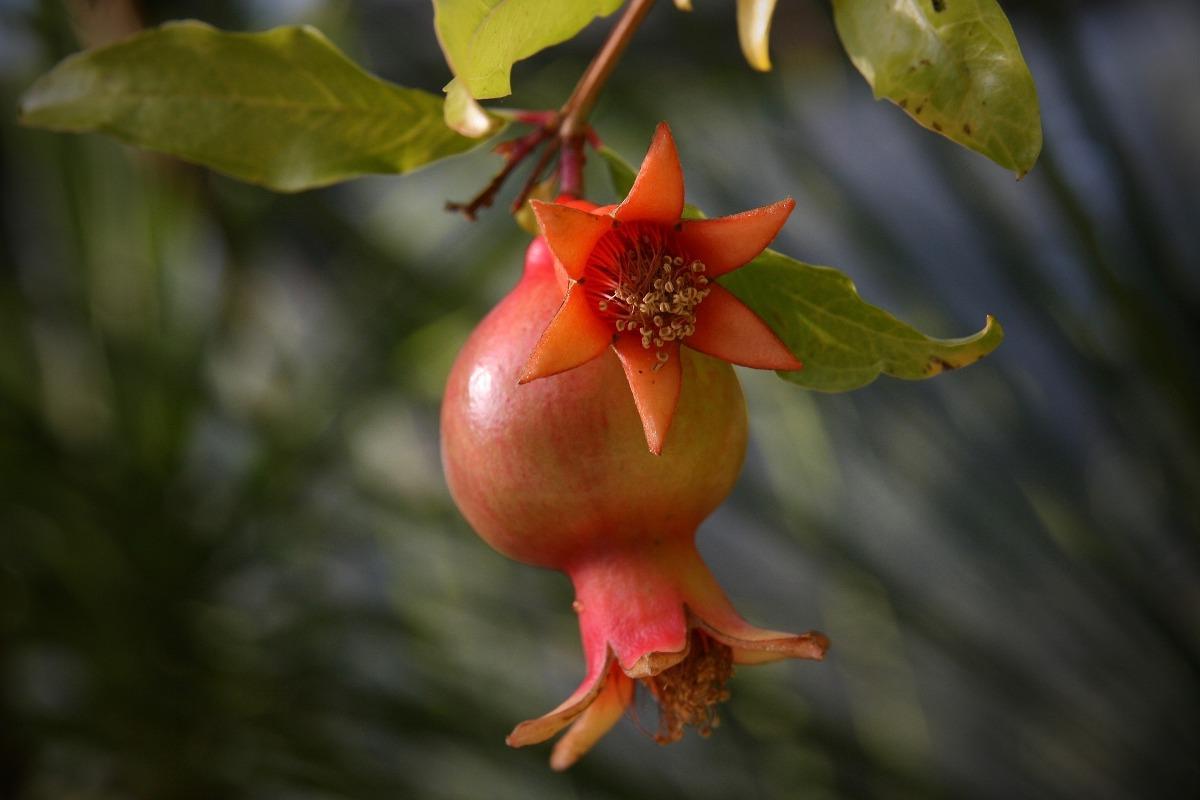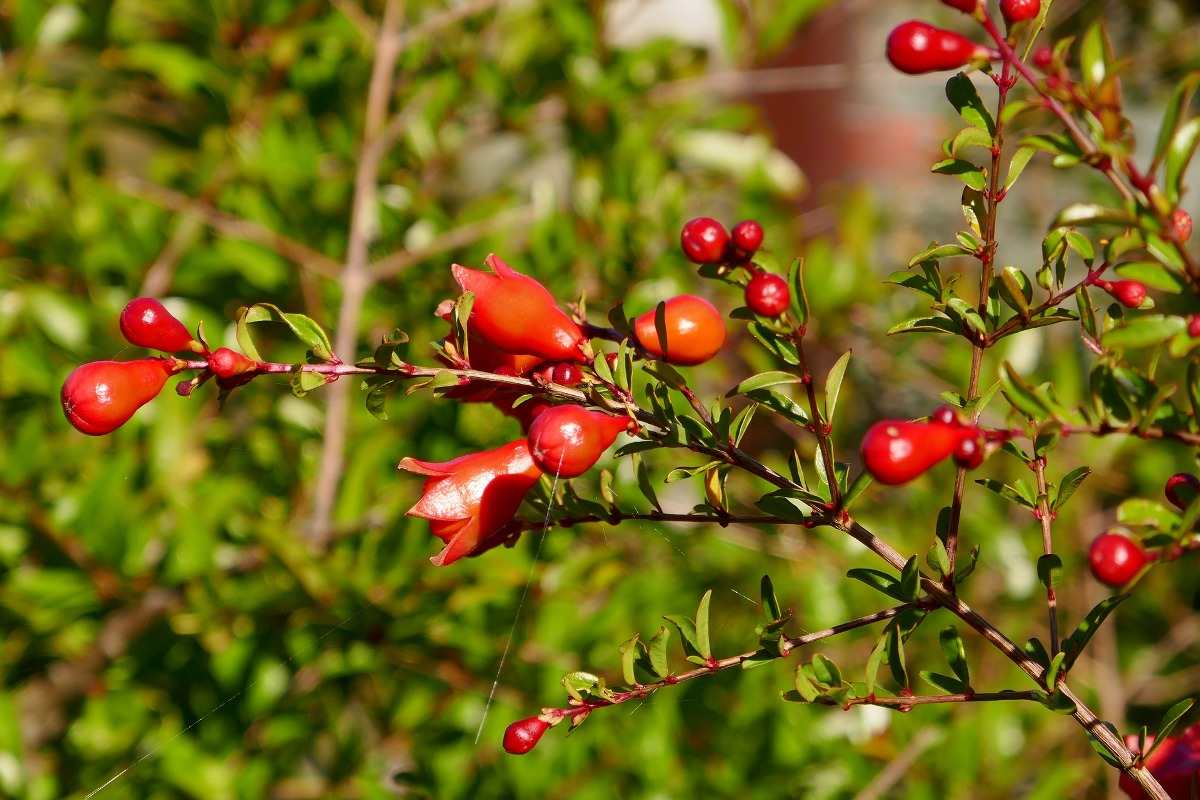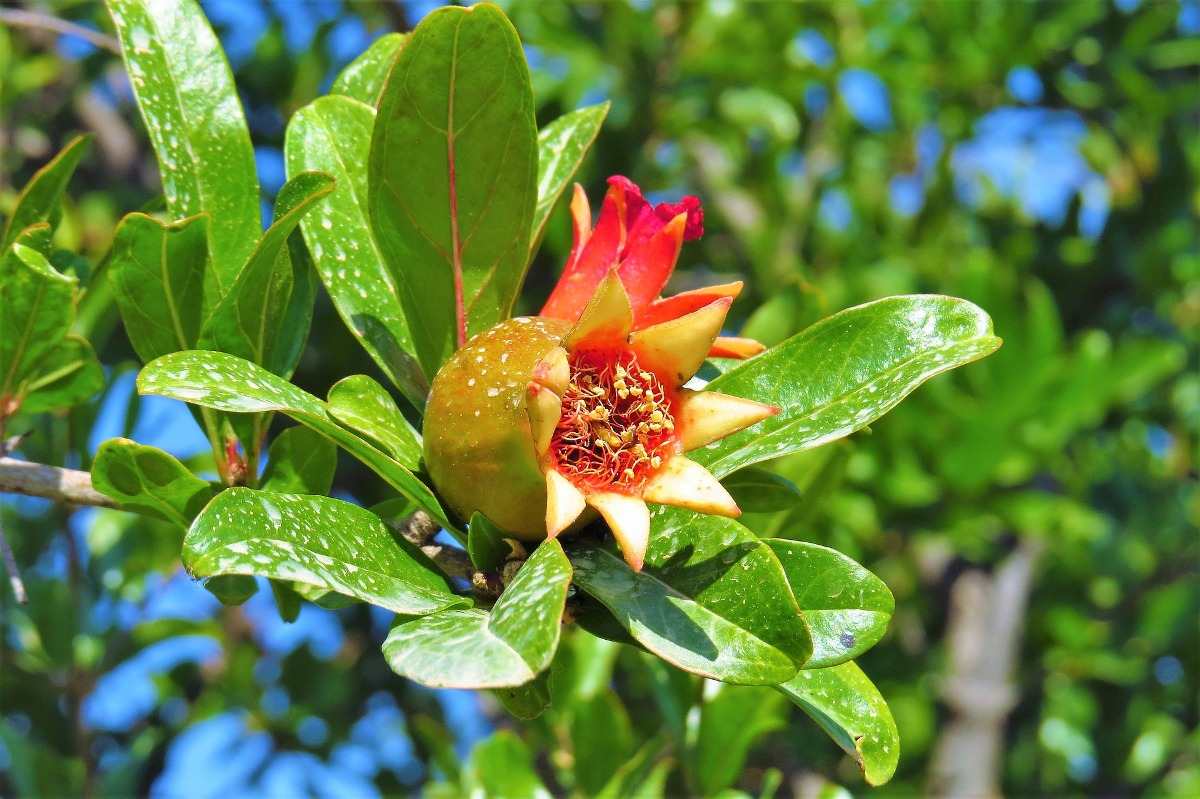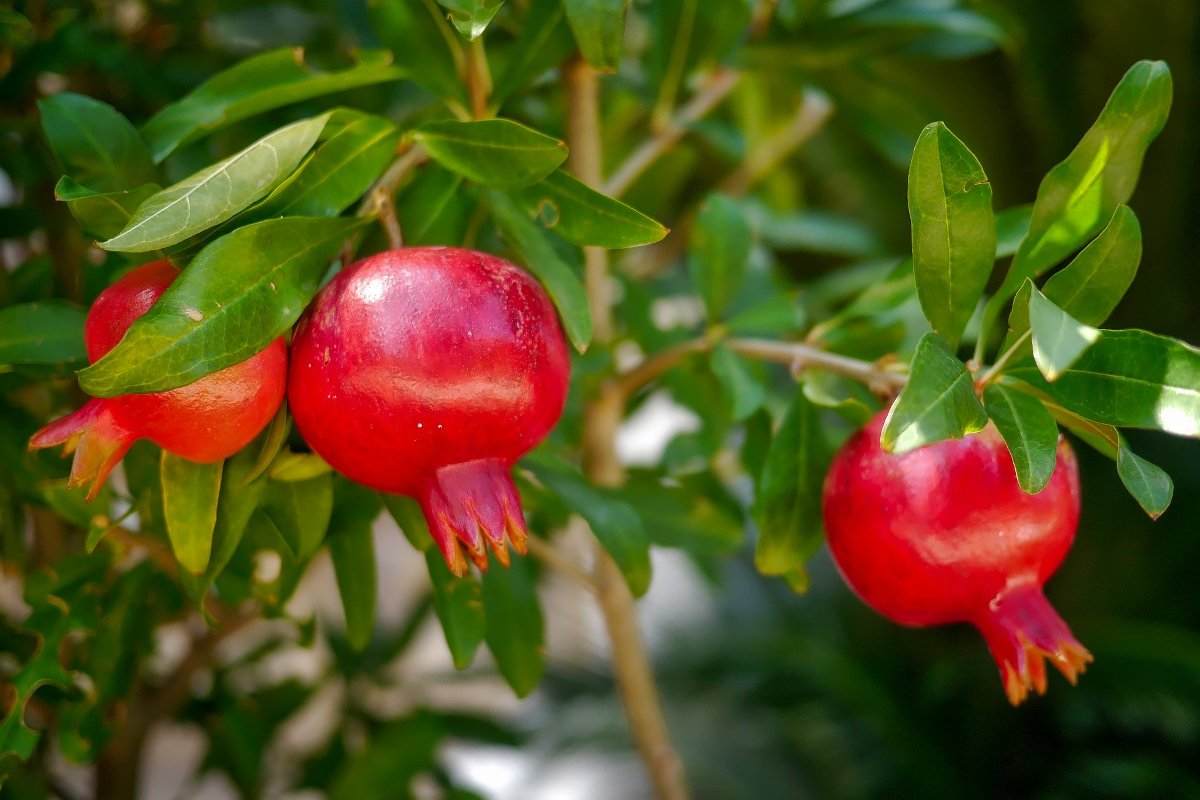Introduction to Pomegranate fruit and flower drop causes, control methods
Pomegranate is one of the oldest known edible fruits and capable of growing in different agro-climates ranging from tropical to temperate regions of the world. Though, its major cultivation is confined in tropical and sub-tropical regions.
India is the largest Pomegranate plant growing country in the world. Pomegranate is a small tree, measuring less than 4 m when cultivated, though it can reach 7 m in the wild. Some trees could live longer than 100 years. The root is knotty, consistent, and reddish, also well developed and extremely absorbent in saline soils.
The Pomegranate is not demanding of the type of soil but it does not grow in clay soils. The ideal soil must be light, permeable, deep, and fresh. On irrigated land, its water requirement is low. Though, excess watering shortly before the fruit ripening phase can cause fruit cracking. The optimum temperature for the Pomegranate is between 18 to 25°C, preferring a warm climate before cold weather. Good lighting should be ensured to allow the fruits to fully develop their coloration. So, it prefers sunny and sheltered places.
Especially, Pomegranate farmers must be aware of various pests and diseases and environmental factros which can cause the pomegranate flower and fruit drop.
A guide to Pomegranate fruit and flower drop causes and control methods

Tips for growing a healthy Pomegranate crop
- Select a variety resistant or tolerant to major pests
- Select healthy seeds, seedlings, and planting materials
- Treat the seeds, seedlings, and planting materials with recommended pesticides especially biopesticides
- Follow proper spacing
- Soil health improvement (mulching and green manuring whenever applicable)
- Nutrient management particularly organic manures and biofertilizers based on the soil test results. If the dosage of nitrogenous fertilizers is too high the crop becomes too succulent and then susceptible to insects and diseases. If the dosage is too low, the pomegranate crop growth is retarded. Thus, the farmers should apply adequate for the best results. The phosphatic fertilizers should not be applied each and every season as the residual phosphate of the previous season will be obtainable for the current season also.
- Proper irrigation
Flowering and fruiting behavior of Pomegranate
The Pomegranate flowers may be solitary (single) or grouped in twos and threes at the ends of the branches. Normally, cross-pollination occurs by insects that increase the fruit set. Though, wind pollination has an insignificant role. Flowering time changes according to geographical situation and cultivars. In a tropical climate, flowers almost throughout the year whereas, in subtropics, it flowers once a year. Under the tropical condition, Pomegranate flower bud differentiation takes place at varied times. The time span between the start of the flower bud elongation and anthesis varies between 14 to 28 days depending on the plant variety and climatic conditions.
Pomegranate fruiting
This deciduous bush grows from 12 to 20 feet tall and nearly the same in the spread. Some patience is required when growing a Pomegranate tree, as it takes 5 to 7 months for the fruit to become mature and the tree itself needs 2 to 3 years before it bears more than a couple of fruits. In addition, the Pomegranate tree loses its vigor after 15 years or so, although some cultivars can live hundreds of years. The Pomegranate fruit is harvested from October to January. You should not miss the Papaya Fruit and Flower Drop Causes, Control Methods.
Pomegranate fruit drop
The effect of deblossoming treatments on cumulative fruit drop, fruit cracking, and diseased Pomegranate fruit percent was non-significant in both the cultivars. Maximum fruit drop was recorded between the second week of April to the first week of May and then a second peak was observed from the second week of July up to the end of the fruit harvesting period in both the cultivars. Earlier fruit drop was related to increase in competition between the developing ovaries at the time of fruit set and a further upsurge in fruit drop was due to physiological and pathological disorders resulting from a change in climatic factors that is relative humidity, rainfall, and temperature. Now, in the below section, you can find the reasons for pomegranate fruit and flower drop.
Pomegranate fruit drop causes and control

The main causes of Pomegranate fruit drop will be given below;
Juvenile stage
The biggest culprit for fruit drop is the juvenile stage that Pomegranates go through. And most fruit trees go through this. But some fruit trees such as pear trees do not bear until they are ready. But most Pomegranate varieties do no wait. They set fruit on at a young age and the problem is the tree is not big enough to support fruit yet. The result is a fruit drop. Fruit drop is common in the first 3-5 years of a young Pomegranate tree’s stage of the growth cycle. Try not to be alarmed. This will change as the Pomegranate tree matures.
Lack of water
Excessive heat over a period of time can dry out the ground rather quickly. When a Pomegranate tree has infrequent water supply it could cause fruit drop or too much water can cause cracked Pomegranate fruit. Then, use drip irrigation so you can give your Pomegranate tree consistent amounts of water. There are certain soil types that dry out quicker. Sandy loam soil type is good for trees, but for a prolonged period without rain can become very dry. Usually, the first place to look to know if the Pomegranate tree is too dry is the leaves because they will discolor and start falling off as the first sign of a distressed tree.
Nutrient deficiency
A lack of nutrients can affect fruit drop. The overall health of the Pomegranate tree is affected by the lack of nutrients. Not all soil types are created equal. Also available a soil test kit with detailed instructions for your soil test. Once soil test results come back, then you will know what to do to increase your Pomegranate production by adding the right nutrients to feed your tree to lessen fruit drop.
Over fertilization
Unless you have a sandy soil that doesn’t hold nutrients well, Pomegranate plants require very little fertilizer. Don’t fertilize Pomegranate at all during their first year of life. Starting in the second year, trees can be fed as directed on the product label with organic plant food or an inorganic fertilizer such as a slow-release shrub and tree type fertilizer. Otherwise, Pomegranate can be fed simply by mulching with organic compost. Spread fertilizer from a point a foot or so beyond the trunk to 6 inches beyond the branch perimeter for every foot in height of the Pomegranate tree.
Often people want to over fertilizer. Too much fertilization can lead to excessive leaf development, giving the plant a dense, bushy appearance. Excessive leaf production causes the Pomegranate to prematurely drop its fruit. Applying too much fertilizer or applying it later in the year than recommended can cause the fruit to mature late, and have poor color. One of the major problems is too much nitrogen. Nitrogen can cause prolific growth, but too much can cause fruit drop. Remember, overfeeding your Pomegranate tree can be just as bad as not fertilizing your Pomegranate tree.
Shade
Not enough hours of sunlight can affect the overall health of Pomegranate causing fruit drop. Be aware of other trees near the Pomegranate tree. The Pomegranate is normally a dense plant that grows more like a shrub. It can be trained to grow like a tree by removing sucker growth and shoots from the base and crown of the Pomegranate tree. It is important to trim some of the inner branches to allow sunlight to reach into your whole tree.
Inadequate pollination
Naturally, insufficiently pollinated young Pomegranate fruit will be shed. This can be caused by an inadequate presence of pollination helpers (like bees) during the bloom time of trees. Often, the fruit that is dropped is malformed, with few seeds, which is another effect of inadequate pollination. Pollination is key to improving trees’ ability to hold fruit and not have a fruit drop.
Number of reasons for Pomegranate flower drop and control methods
In case, if you miss this: Basic Steps of Organic Farming.

Pollination
To answer the question of why Pomegranate flowers fall off, we want to know a little about the plants’ reproduction. Pomegranate trees are self-fruitful; this means the flowers on the Pomegranate are both male and female. Then, pollinating insects and hummingbirds assist in spreading the pollen from flower to flower. By using a small brush and lightly brushing from bloom to bloom. Male Pomegranate flowers fall off naturally as do un-fertilized female blooms, while fertilized female flowers remain to become Pomegranate fruit.
Pests
These Pomegranate trees begin to flower in May and continue through early autumn. If Pomegranate flowers fall off in early spring, the culprit may be insect infestation such as whitefly, scale or mealybugs. Inspect the tree for damage and consult a local nursery or a recommendation regarding the use of an insecticide.
Diseases
Another possible reason for the Pomegranate flower drop can be due to a fungal disease or root rot. An anti-fungal spray must be applied and again, the local nursery can help with this.
Environmental conditions
The Pomegranate tree may drop flowers due to cold temperatures as well, so it is a good idea to protect the tree if a chill is in the forecast.
Finally, the tree is drought resistant; it still needs a good deep watering if you want it to produce fruit. Too little water will cause the blossoms to drop from the Pomegranate tree. Pomegranate trees want to be mature to produce fruit, three to five years or so. Prior to this, as long as the tree is watered, fertilized, pollinated properly, and free of pests and disease, a little flower drop is perfectly natural and no cause for alarm. Just be patient and eventually you, too, can be enjoying the delicious ruby-red fruit of very own exotic Pomegranate.
Get a Pomegranate tree to hold fruit
Young trees are prone to a moderate amount of fruit drop. This proclivity increases under stressful conditions and can be controlled with good care. Mature trees are less likely to drop fruit but, like young Pomegranate trees, will do so under conditions of improper watering and over-fertilization.
Measure the soil around the Pomegranate tree regularly with a moisture meter. Moisture meters are obtainable from home and garden centers. Adjust watering practices so that tree receives 1 inch of water per week and more during times of intense heat. Underwatering in spring or summer can create stressful drought conditions for the tree. The moisture meter will indicate more water during hot weather. Cease watering when the tree receives about 1 inch or more of rainfall per week. Overwatering favors excessive vegetation and can lead to low fruit production or fruit drop.
Apply 1 pound of 10-10-10 or 8-8-8 fertilizer for every 3 feet of tree height, once in March and once in July. Broadcast the fertilizer evenly over the soil around the Pomegranate tree, staying approximately 6 inches away from the tree’s base. Water deeply after fertilizing.
Reduce fertilization for Pomegranate trees that have an abundance of healthy vegetation without fruit set, as this is a symptom of over-fertilization. Thin the branches by pruning, and using sanitized pruning shears. Annual light pruning in early spring will allow light into the dense foliage of the shrub, providing light for the Pomegranate fruits. Remove dead branches and branches that rub.
Remove any nearby obstructions that can cause the Pomegranate tree to fall into shade. Pomegranate fruits produce best in full sunlight. Consider planting a second Pomegranate shrub nearby on the property. Though Pomegranates are self-pollinating, cross-pollination can improve yields and fruit quality.
Commonly asked questions about Pomegranate cultivation
You may also check the Groundnut Seed Germination, Time, Temperature, Process.

How to overcome bird damage during the fruiting stage?
By covering fruits with polypropylene bags or covering the plants/plots with nets.
What is the recommended spacing for Pomegranate plantation?
Pomegranate planting distance is decided on the basis of soil type and climate. A spacing of 4-5 meters on marginal and very light soils is recommended. Pits of 60 X 60 X 60 cm.
How do you make a Pomegranate flower better?
Intermediate flowers can mature into fruits. If your Pomegranate plant has a lesser number of hermaphrodite flowers than you can make a solution of seaweed extract or some other plant flowering hormone and spray it on the Pomegranate plant. This will increase the ratio of hermaphrodite Pomegranate flowers on the plant.
Is Pomegranate self-pollinating?
Most Pomegranates are self-fruitful, meaning they do not need another tree to cross-pollinate with, as the bees do all the work. That said, planting another Pomegranate nearby can increase Pomegranate fruit production on both plants. A little cross-pollination can’t hurt, but it isn’t necessary.
Why is the Pomegranate tree not producing fruit?
There is little wind dispersal of pollen so most of the pollination is done by bees. Thus, if you have a Pomegranate tree that is not producing fruit, the most likely explanation is a lack of pollinators.
How do you increase the Pomegranate fruit size?
Even though fertilizing based on a nutrient basis is important, there are 3 main reasons that will help increase the size. The Pomegranate fruit size is increased under all Nitrogen, Phosphorus, and Potassium, treatments.
What month does Pomegranate bloom?
The blooming period is relatively long for Pomegranates (April–June), but later-blooming flowers could not have time to develop into fully ripe fruit. Fruit ripening takes around 6 to 7 months for most Pomegranates, so flowers blooming in April and May.
How do you know when a Pomegranate is ready to pick?
When harvesting Pomegranate fruit, pick when the Pomegranate fruit is fully ripe and a deep red in color since it does not continue to ripe post-harvest. Begin picking Pomegranates when the fruit makes a metallic sound when you tap it with a finger.
What is the ideal age for taking fruit after planting?
It is advisable to regulate flowering after 3 years of planting; however, it can be taken after 2 years if plant growth and vigor are good.
Conclusion of Pomegranate fruit and flower drop
Well, as a commercial Pomegranate grower, you must be aware of the reasons for Pomegranate fruit and flower drop to control them and get a good yield. You may also like the Growing Dragon Fruit from Cuttings and Seed.